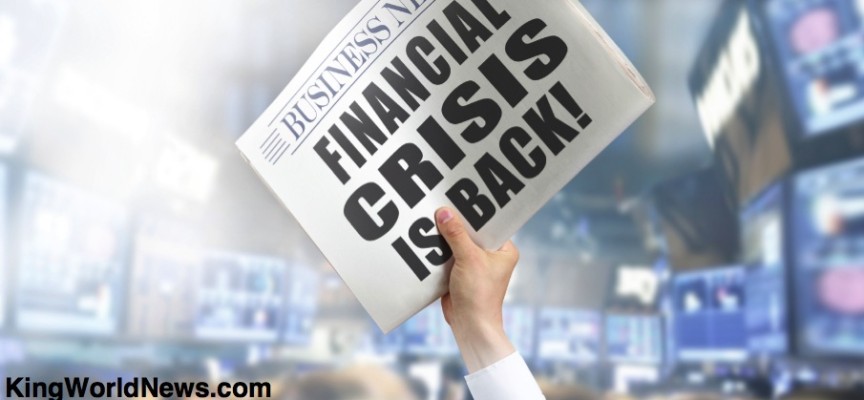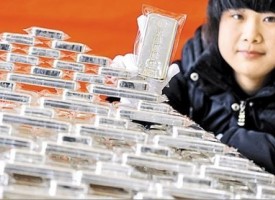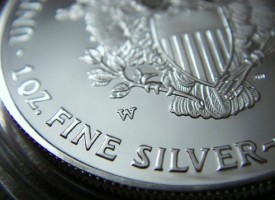With the Dow and NASDAQ tumbling along with bonds, the financial war is heating up as the West edges closer to violent currency, banking and market collapse.
Financial War Takes A Nasty Turn
May 5 (King World News) – Alasdair Macleod: The chasm between Eurasia and the Western defence groupings (NATO, Five-eyes, AUKUS etc.) is widening rapidly. While media commentary focuses on the visible side of the conflict in Ukraine, the economic and financial aspects are what really matter.
There is an increasing inevitability about it all. China has been riding the inflationist Western tiger for the last forty years and now that it sees the dollar’s debasement accelerating wonders how to get off. Russia perhaps is more advanced in its plans to do without dollars and other Western currencies, hastened by sanctions. Meanwhile, the West is increasingly vulnerable with no apparent alternative to the dollar’s hegemony.
By imposing sanctions on Russia, the West has effectively lined up its geopolitical opponents into a common cause against an American dollar-dominated faction. Russia happens to be the world’s largest exporters of energy, commodities, and raw materials. And China is the supplier of semi-manufactured and consumer goods to the world. The consequences of the West’s sanctions ignore this vital point.
In this article, we look at the current state of the world’s financial system and assess where it is headed. It summarises the condition of each of the major actors: the West, China, and Russia, and the increasing urgency for the latter two powers to distance themselves from the West’s impending currency, banking, and financial asset crisis.
We can begin to see how the financial war will play out.
The West and its dollar-based pump-and-dump system
The Chinese have viewed the US’s tactics under which she has ensured her hegemony prevails. It has led to a deep-seated distrust in her relationship with America. And this is how she sees US foreign policy in action.
Since the end of Bretton Woods in August 1971, for strategic reasons as much as anything else America has successfully continued to dominate the free world. A combination of visible military capability and less visible dollar hegemony defeated the communism of the Soviets and Mao Zedong. Aid to buy off communism in Africa and Latin America was readily available by printing dollars for export, and in the case of Latin America by deploying the US banking system to recycle petrodollars into syndicated loans. In the late seventies, banks in London would receive from Citibank yards-long telexes inviting participation in syndicated loans, typically for $100 million, the purpose of which according to the telex was invariably “to further the purposes of the state.”
Latin American borrowing from US commercial banks and other creditors increased dramatically during the 1970s. At the commencement of the decade, total Latin American debt from all sources was $29 billion, but by the end of 1978, that number had skyrocketed to $159 billion. And in early-1982, the debt level reached $327 billion. We all knew that some of it was disappearing into the Swiss bank accounts of military generals and politicians of countries like Argentina. Their loyalty to the capitalist world was being bought and it ended predictably with the Latin American debt crisis…
This gold company just made one of the biggest deals of 2022
and is now set up for monster upside! To learn more
click here or on the image below.
With consumer price inflation raging, the Fed and other major central banks had to increase interest rates in the late seventies, and the bank credit cycle turned against the Latins. Banks sought to curtail their lending commitments and often (such as with floating-rate notes) they were paying higher coupon rates. In August 1982, Mexico was the first to inform the Fed, the US Treasury, and the IMF that it could no longer service its debt. In all, sixteen Latin American countries rescheduled their debts subsequently as well as eleven LDCs in other parts of the world.
America assumed the lead in dealing with the problems, acting as “lender of last resort” working with central banks and the IMF. The rump of the problem was covered with Brady Bonds issued between 1990—1991. And as the provider of the currency, it was natural that the Americans gave a pass to their own corporations as part of the recovery process, reorganising investment in production and economic output. So, a Latin American nation would have found that America provided the dollars required to cover the 1970s oil shocks, then withdrew the finance, and ended up controlling swathes of national production.
That was the pump and dump cycle which informed Chinese military strategists analysing US foreign policy some twenty years later. In 2014, the Chinese leadership was certain the riots in Hong Kong reflected the work of American intelligence agencies. The following is an extract translated from a speech by Major-General Qiao Liang, a leading strategist for the Peoples’ Liberation Army, addressing the Chinese Communist Party’s Central Committee in 2015:
“Since the Diaoyu Islands conflict and the Huangyan Island conflict, incidents have kept popping up around China, including the confrontation over China’s 981 oil rigs with Vietnam and Hong Kong’s “Occupy Central” event. Can they still be viewed as simply accidental?
I accompanied General Liu Yazhou, the Political Commissar of the National Defence University, to visit Hong Kong in May 2014. At that time, we heard that the “Occupy Central” movement was being planned and could take place by end of the month. However, it didn’t happen in May, June, July, or August.
What happened? What were they waiting for?
Let’s look at another timetable: the U.S. Federal Reserve’s exit from the Quantitative Easing (QE) policy. The U.S. said it would stop QE at the beginning of 2014. But it stayed with the QE policy in April, May, June, July, and August. As long as it was in QE, it kept overprinting dollars and the dollar’s price couldn’t go up. Thus, Hong Kong’s “Occupy Central” should not happen either.
At the end of September, the Federal Reserve announced the U.S. would exit from QE. The dollar started going up. Then Hong Kong’s “Occupy Central” broke out in early October.
Actually, the Diaoyu Islands, Huangyan Island, the 981 rigs, and Hong Kong’s “Occupy Central” movement were all bombs. The successful explosion of any one of them would lead to a regional crisis or a worsened investment environment around China. That would force the withdrawal of a large amount of investment from this region, which would then return to the U.S.”
For the Chinese, there was and still is no doubt that America was out to destroy China and stood ready to pick up the pieces, just as it had done to Latin America, and South-East Asia in the Asian crisis in 1997. Events since “Occupy Central” will have only confirmed that view and explains why the Chinese dealt with the Hong Kong problem the way they did, when President Trump mounted a second attempt to derail Hong Kong, with the apparent objective to prevent global capital flows entering China through Shanghai Connect.
For the Americans the world is slipping out of control. They have had expensive wars in the Middle East, with nothing to show for it other than waves of displaced refugees. For them, Syria was a defeat, even though that was just a proxy war. And finally, they had to give up on Afghanistan. For her opponents, America has lost hegemonic control in Eurasia and if given sufficient push can be removed from the European mainland entirely. Undoubtedly, that is now Russia’s objective. But there are signs that it is now China’s as well, in which case they will have jointly obtained control of the Eurasian land mass.
Financial crisis facing the dollar
The geopolitics between America and the two great Asian states have been clear for all of us to see. Less obvious has been the crisis facing Western nations. Exacerbated by American-led sanctions against Russia, producer prices and consumer prices are not only rising, but are likely to continue to do so. In particular, the currency and credit inflation of not only the dollar, but also the yen, euro, pound, and other motley fiat currencies have provided the liquidity to drive prices of commodities, producer prices and consumer prices even higher. In the US, reverse repos which absorb excess liquidity currently total nearly $2 trillion. And the higher interest rates go, other things being equal the higher this balance of excess currency no one wants will rise.
And rise they will. The strains are most obvious in the yen and the euro, two currencies whose central banks have their interest rates stuck below the zero bound. They refuse to raise them, and their currencies are collapsing instead. But when you see the ECB’s deposit rate at minus 0.5%, producer prices for Germany rising at an annualised rate of over 30%, and consumer prices already rising at 7.5% and sure to go higher, you know they will all go much, much higher…
To find out which silver company just made a major acquisition that will
quadruple their production click here or on the image below

Like the Bank of Japan, the ECB and its national central banks through quantitative easing have assembled substantial portfolios of bonds, which with rising interest rates will generate losses which will drive them rapidly into insolvency. Furthermore, the two most highly leveraged commercial banking systems are the Eurozone’s and Japan’s with assets to equity ratios for the G-SIBs of over twenty times. What this means is that less than a 5% fall in the value of its assets will bankrupt the average G-SIB bank.
It is no wonder that foreign depositors in these banking systems are taking fright. Not only are they being robbed through inflation, but they can see the day when the bank which has their deposits might be bailed in. And worse still, any investment in financial assets during a sharply rising interest environment will rapidly lose value.
For now, the dollar is seen as a haven from currencies on negative yields. And in the Western world, the dollar as the reserve currency is seen as offering safety. But this safety is an accounting fallacy which supposes that all currency volatility is in the other fiat currencies, and not the dollar. Not only do foreigners already own dollar-denominated financial assets and bank deposits totalling over $33 trillion, but rising bond yields will prick the dollar’s financial asset bubble wiping out much of it.
In other words, there are currently winners and losers in currency markets, but everyone will lose in bond and equity markets. Add into the mix counterparty and systemic risks from the Eurozone and Japan, and we can say with increasing certainty that the era of financialisation, which commenced in the 1980s, is ending.
This is a very serious situation. Bank credit has become increasingly secured on non-productive assets, whose value is wholly dependent on low and falling interest rates. In turn, through the financial engineering of shadow banks, securities are secured on yet more securities. The $610 trillion of OTC derivatives will only provide protection against risk if the counterparties providing it do not fail. The extent to which real assets are secured on bank credit (i.e., mortgages) will also undermine their values.
Clearly, central banks in conjunction with their governments will have no option but to rescue their entire financial systems, which involves yet more central bank credit being provided on even greater scales than seen over covid, supply chain chaos, and the provision of credit to pay for higher food and energy prices. It must be unlimited.
We should be in no doubt that this accelerating danger is at the top of the agenda for anyone who understands what is happening — which particularly refers to Russia and China.
Russia’s aggressive stance
There can be little doubt that Putin’s aggression in Ukraine was triggered by Ukraine’s expressed desire to join NATO and America’s seeming acquiescence. A similar situation had arisen over Georgia, which in 2008 triggered a rapid response from Putin. His objective now is to get America out of Europe’s defence system, which would be the end of NATO. Consider the following:
- America’s military campaigns on the Eurasian continent have all failed, and Biden’s withdrawal from Afghanistan was the final defeat.
- The EU is planning its own army. Being an army run by committee it will lack focus and be less of a threat than NATO. This evolution into a NATO replacement should be encouraged.
- As the largest supplier of energy to the EU, Russia can apply maximum pressure to speed up the political process.
The most important commodity for the EU is energy. And through EU policies, which have been to stop producing carbon-based energy and to import it instead, the EU has become dependent on Russian oil, natural gas, and coal. And by emasculating Ukraine’s production, Putin is putting further pressure on the EU with respect to food and fertiliser, which will become increasingly apparent over the course of the summer.
For now, the EU is toeing the American line, with Brussels instructing member states to stop importing Russian oil from the end of this year. But already, it is reported that Hungary and Slovakia are prepared to buy Russian oil and pay in roubles. And it is likely that while other EU governments will avoid direct contractual relationships with Russia, ways round the problem indirectly are being pursued.
A sticking point for EU governments is having to pay in roubles. Otherwise, the solution is simple: non-Russian, non-EU banks can create a Eurorouble market overnight, creating rouble bank credit as needed. All that such a bank requires is access to rouble liquidity to manage a balance sheet denominated in roubles. The obvious providers of rouble credit are China’s state-controlled megabanks. And we can be reasonably sure that at his meeting with President Xi on 4 February, not only would the intention to invade Ukraine have been discusseded, but the role of China’s banks in providing roubles for the “unfriendlies” (NATO and its supporters) in the event of Western sanctions against Russia will have been as well.
The point is that Russia and China have mutual geopolitical objectives, and what might have come as a surprise to the West was most likely agreed between them in advance.
The recovery in the rouble from the initial hit to an intraday low of 150 to the dollar has taken it to 64 at the time of writing. There are two factors behind this recovery. The most important is Putin’s announcement that the unfriendlies will have to pay for energy in roubles. But there was a subsidiary announcement that the Russian central bank would be buying gold. Notionally, this was to ensure that Russian banks providing finance to gold mines could gold and other related assets as collateral. But the central bank had stopped buying gold and accumulated the unfriendlies currencies in its reserves instead. This was taken by senior figures in Putin’s administration as evidence that the highly regarded Governor, Elvira Nabiullina, had been captured by the West’s BIS-led banking system.
Russia has now realised that foreign exchange reserves which can be blocked by the issuers are valueless as reserves in a crisis, and that there is no point in having them. Only gold, which has no counterparty risk can discharge this role. And it is a lesson not lost on other central banks either, both in Asia and elsewhere.
But this sets the rouble onto a different course from the unbacked fiat currencies in the West. This is deliberate, because while rising interest rates will lead to a combined currency, banking, and financial asset crisis in the West, it is a priority of the greatest importance for Russia to protect herself from these developments.
A new backing for the rouble
Russia is determined to protect herself from a dollar currency collapse. So far as Russia is concerned, this collapse will be reflected in rising dollar prices for her exports. And only last week, one of Putin’s senior advisors, Nikolai Patrushev, confirmed in an interview with Rossiyskaya Gazeta that plans to link the rouble to commodities are now being considered. If this plan goes ahead, the intention must be for the rouble to be considered a commodity substitute on the foreign exchanges, and its protection against a falling dollar will be secured.
We are already seeing the rouble trending higher, with it at 64 to the dollar yesterday. Figure 1 below shows its progress, in the dollar-value of a rouble.
Keynesians in the West have misread this situation. They think that the Russian economy is weak and will be destabilised by sanctions. That is not true. Furthermore, they would argue that a currency strengthened by insisting that oil and natural gas are paid for in roubles will push the Russian economy into a depression. But that is only a statistical effect and does not capture true economic progress or the lack of it, which cannot be measured. The fact is that the shops in Russia are well stocked, and fuel is freely available, which is not necessarily the case in the West.
The advantages for Russia are that as the West’s currencies sink into crisis, the rouble will be protected. Russia will not suffer from the West’s currency crisis, she will still get inflation compensation in commodity prices, and her interest rates will decline while those in the West are soaring. Her balance of trade surplus is already hitting new records.
There was a report, attributed to Dmitri Peskov, that the Kremlin is considering linking the rouble to gold and the idea is being discussed with Putin. But that’s probably a rehash of the interview that Nickolai Patrushev recorded with Rossiyskaya Gazeta referred to above, whereby Russia is considering fixing the rouble against a wider range of commodities. At this stage, a pure gold standard for the rouble of some sort would have to take the following into account:
- History has shown that the Americans and the West’s central banks manipulate gold prices through the paper markets. To fix the rouble against a gold standard would hold it a hostage to fortune in this sense. It would be virtually impossible for the West to manipulate the rouble by intervening in this way across a range of commodities.
- Over long periods of time the prices of commodities in gold grams are stable. For example, the price of oil since 1950 has fallen by about 30%. The volatility and price rises have been entirely in fiat currencies. The same is true for commodity prices generally, telling us that not only are commodities priced in gold grams generally stable, but a basket of commodities can be regarded as tracking the gold price over time and therefore could be a reasonable substitute for it.
- If Russia has significant gold bullion quantities in addition to declared reserves, these will have to be declared in conjunction with a gold standard. Imagine a situation where Russia declares and can prove that it has more gold that the US Treasury’s 8,133 tonnes. Those who appear to be in a position to do so assess the true Russian gold position is over 10,000 tonnes. Combined with China’s undeclared gold reserves, such an announcement would be a financial nuclear bomb, destabilising the West.
- For this reason, Russia’s partner, China, for which exporting semi-manufactured and consumer goods to the West is central to her economy activities, would prefer an approach that does not add to the dollar’s woes directly. The Americans are doing enough to undermine the dollar without a push from Asia’s hegemons.
Furthermore, a mechanism for linking the rouble to commodity prices has yet to be devised. The advantage of a gold standard is it is a simple matter for the issuer of a currency to accept notes from the public and to pay out gold coin. And arbitrage between gold and roubles would ensure the link works on the foreign exchanges. This cannot be done with a range of commodities. It will not be enough to simply declare the market value of a commodity basket daily. Almost certainly forex traders will ignore the official value because they have no means of arbitrage.
It is likely, therefore, that Russia will take a two-step approach. For now, by insisting on payments in roubles by the unfriendlies domestic Russian prices for commodities, raw materials and foods will be stabilised as the unfriendlies’ currencies fall relative to the rouble. Russia will find that attempts to tie the currency to a basket of currencies is impractical. After the West’s currency, banking, and financial asset crisis has passed then there will be the opportunity to establish a gold standard for the rouble.
The Eurasian Economic Union
While it is impossible to formally tie a currency which trades on the foreign exchanges to a basket of commodities, the establishment of a virtual currency specifically for trade settlement between jurisdictions is possible. This is the basis of a project being supervised by Sergei Glazyev, whereby such a currency is planned to be used by the member states of the Eurasian Economic Union (EAEU). Glazyev is Russia’s Minister in charge of integration and macroeconomics of the EAEU. While planning to do away with dollars for trade settlements has been in the works for some time, sanctions by the unfriendlies against Russia has brought about a new urgency.
We know no detail, other than what was revealed in an interview Glazyev gave recently to a media outlet, The Cradle [ii]. But the desire to do away with dollars for the countries involved has been on the agenda for at least a decade. In October 2020, the original motivation was explained by Victor Dostov, president of the Russian Electronic Money Association:
“If I want to transfer money from Russia to Kazakhstan, the payment is made using the dollar. First, the bank or payment system transfers my roubles to dollars, and then transfers them from dollars to tenge. There is a double conversion, with a high percentage taken as commission by American banks.”
The new trade currency will be synthetic, presumably price-fixed daily, giving conversion rates into local currencies. Operating rather like the SDR, state banks can create the new currency to provide the liquidity balances for conversion. It is a practical concept, which being relatively advanced in the planning, is probably the reason the Kremlin is considering it as an option for a future rouble.
That idea of a commodity basket for the rouble itself is bound to be abandoned, while a successful EAEU trade settlement currency can be extended to both the wider Shanghai Cooperation Organisation and the BRICS members not in the SCO.
China’s position
We can now say with confidence that at their meeting on 4 February Putin and Xi agreed to the Ukraine invasion. Chinese interests in Ukraine are affected, and the consequences would have had to be discussed.
The fact that Russia went ahead with its war on Ukraine makes China complicit, and we must therefore analyse the position from China’s point of view. For some time, America has attacked China’s economy, trying to undermine it. I have already detailed the position over Hong Kong, to which can be added other irritations, such as the arrest of Huawei’s chief financial officer in Canada on American instructions, trade tariffs, and the sheer unpredictability of trade policy during the Trump administration.
President Biden and his administration have now been assessed by both Putin and Xi. By 4 February their economic and banking advisors will have made their recommendations. Outsiders can only come to one conclusion, and that is Russia and China decided at that meeting to escalate the financial war on the West.
Their position is immensely strong. While Russia is the largest exporter of energy and commodities in the world, China is the largest provider of intermediate and consumer goods. Other than the unfriendlies, nearly all other nations are neutral and will understand that it is not in their interests to side with NATO, the EU, Japan and South Korea. The only missing piece of the jigsaw is China’s commoditisation of the renminbi.
Following the Fed’s reduction of its funds rate to the zero bound and its monthly QE increase to $120bn per month, China began to aggressively stockpile commodities and grains. In effect, it was a one-nation crack-up boom, whereby China took the decision to dump dollars. The renminbi rose against the dollar, but by considerably less than the dollar’s loss of purchasing power. This managed exchange rate for the renminbi appears to have been suppressed to relieve China’s exporters from currency pressures, at a time when the Chinese economy was adversely affected first by credit contraction, then by covid and finally by supply chain disruptions.
With respect to supply chains, current lockdowns in Shanghai and the logjam of container vessels in the Roads look set to emasculate Western economies with supply chain issues for the rest of the year. All we know is that the authorities are making things worse, but we don’t know whether it is deliberate.
It is increasingly difficult to believe that the financial and currency war is not being purposely escalated by the Chinese-Russian partnership. Having attacked Ukraine, the West’s response is undermining their own currencies, and the urgency for China and Russia to protect their currencies and financial systems from the consequences of a fiat currency crisis has become acute.
It is the financial war which is going “nuclear”. Talk in the West of the military war escalating towards a physical nuclear war misses this point. China and Russia now realise they must protect themselves from the West’s looming currency and economic crisis as a matter of urgency. To fail to do so would simply ensure the crisis overwhelms them as well.
ALSO RELEASED: BANKING COLLAPSE? A Large Client Somewhere Has Blown Up CLICK HERE.
ALSO RELEASED: Eurozone Inflation Hits A Jaw-Dropping 36.8% CLICK HERE.
ALSO RELEASED: Russian Ruble & Gold, Trouble In China, Plus Even More Inflation And Silver’s Fall CLICK HERE.
ALSO RELEASED: What We Are Seeing Is Unparalleled In History But Here Is The Good News CLICK HERE.
ALSO RELEASED: Greyerz – Global Chaos Will Increase As The World Is Now Standing On The Edge Of A Precipice CLICK HERE.
MUST LISTEN: Egon von Greyerz’s Partner Matthew Piepenburg gave an absolutely incredible interview about the coming chaos investors should expect to see in terms of inflation and major markets as well as gold, silver, and what people will need to do in order to protect themselves from the coming upheaval in global markets. I would encourage everyone around the world to listen to this remarkable interview by CLICKING HERE OR ON THE IMAGE BELOW.
To listen to Alasdair Macleod discuss Russia backing the ruble with gold and why the price of gold’s rise will be unstoppable CLICK HERE OR ON THE IMAGE BELOW.
© 2022 by King World News®. All Rights Reserved. This material may not be published, broadcast, rewritten, or redistributed. However, linking directly to the articles is permitted and encouraged.











